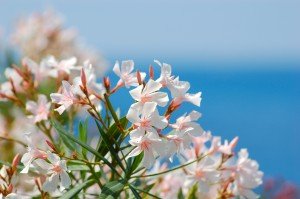RE: Oleander - Beautiful but Deadly.
Kaner (Nerium oleander/indicum) is an ornamental shrub or small, densely branched tree, 1 to 10 m tall in the Dogbane family Apocynaceae. Leaves are in pairs of three or whorled, very green, leathery, narrowly elliptic to linear entire. Flowers grow in clusters in terminal branches, each 2.5 to 5 cm, funnel-shaped with five lobes, fragrant, various colors from pink to red, white, peach, and yellow.
The common oleander is one of most poisonous plants that have been shown to contain nondigitalis cardiac glycosides. Oleander is an idiom for plants of the N. oleander L, N. indicum, and, Nerium odorum, species. Common names include soland, lorier bol, rosebay, and rose laurel and kaner.
The oleander is most prevalent, and alluring flowers make it a particular hazard for accidental ingestion. The plant also has shown toxicologic importance for accidents when used in folk medicines, when adults unknowingly eat parts of the plant, or food that has come into contact with the plant, such as hot-dog sticks, and in homicides or suicides. Also, as our case illustrates, toxicities are not limited to temperate climates.
All parts of the oleander plant contain cardiac glycosides, including the roots and the smoke produced from burning, as heat does not inactivate the glycosides. The toxic component are the two potent cardiac glycosides, oleanderin and neriine, which can be isolated from all parts of the plant, Both are very similar to the toxin of Foxglove.[4] Both have positive inotropic, negative chronotropic, and cross reactivity. This includes direct glycoside poisoning of the sodium-potassium pump of the heart and increased vagotonia. Most symptoms from oleander poisoning are cardiac and gastrointestinal in nature and appear four hours after the ingestion.




